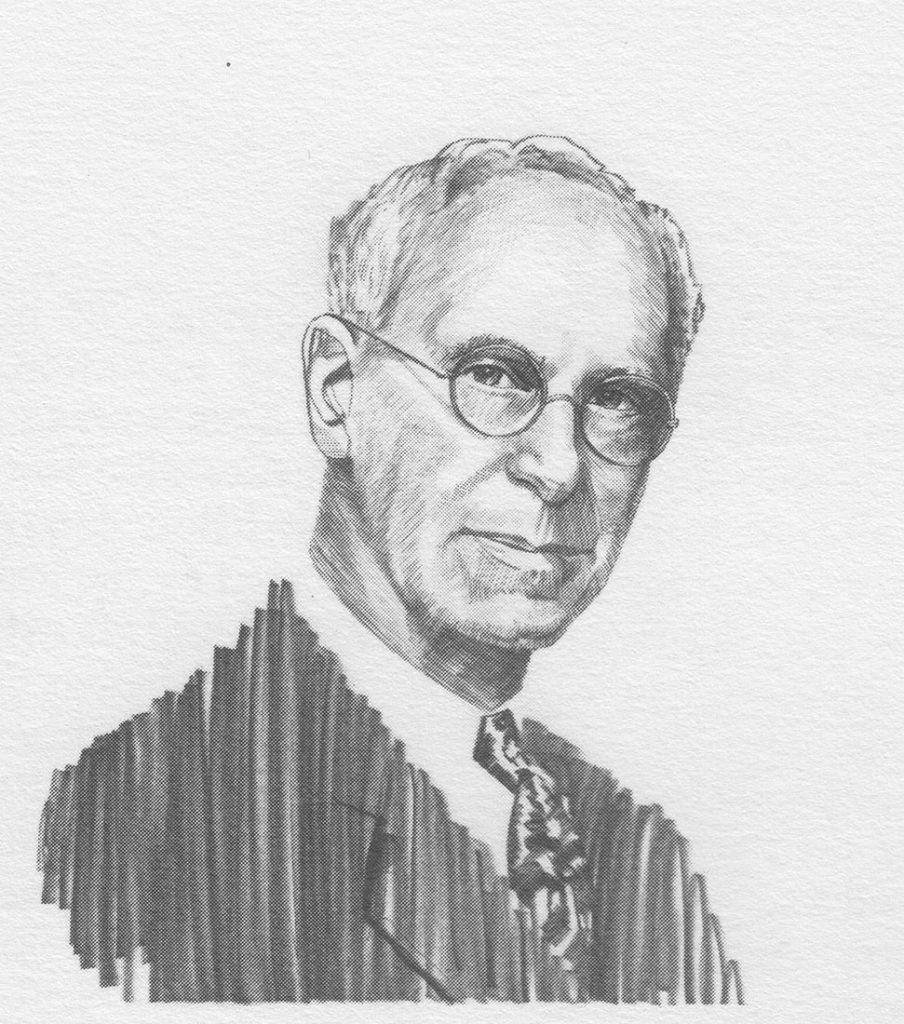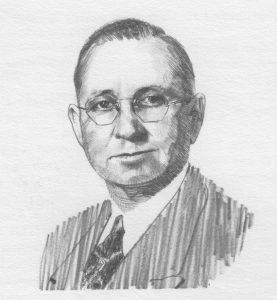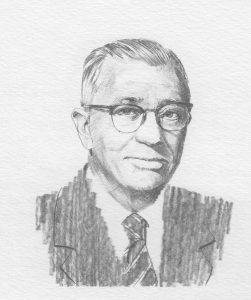Herbert Eugene Westervelt pioneered the modern paper industry in his chosen home state, Alabama, when his company’s far-flung pulp, paper, converting, and administrative operation were consolidated in Tuscaloosa in 1929 under the new name of Gulf States Paper Corporation.
His farsightedness and perseverance put him in the vanguard of that industrial revolution which brought new prosperity to the Southern economy.
Westervelt was born in the frontier town, Oskaloosa, Iowa, on November 20, 1858. His father, a graduate of Oberlin College and a Congregational minister, later moved the family back to Oberlin, Ohio, where proper educational advantages were available for young eight-year-old Herb and the older boys approaching college age. To supplement the meager income of a minister, Father Westervelt opened a small grocery business. All four boys helped in the little store, which opened its doors at 6 p.m. and took orders through the evenings. Herbert and his brothers made deliveries at night, pulling a two-wheeled cart on their rounds. Their hurried evening meals consisted of cheese and crackers, consumed in such amounts that his daughter later recalled, “I cannot remember that my father ever willingly ate a bite of cheese in later life!”
A penny and a nickel at a time, young Herb saved his money. At last, he accumulated a $75 hoard, which he invested in a sight-unseen gold mine! Years later, he observed the only gold he got out of the venture was the seal on the stock certificate and a lot of golden experience.
Those early days, with the brothers working together, not only laid seeds of business acumen but established a perseverance and family tradition of cooperation which was the springboard for the paper company that is still today family-owned.
After two years at Oberlin College, young Westervelt felt his parents had sacrificed enough to educate their sons (the oldest three had graduated) and he determined to make his own contributions to his family. By the time he was28 years of age, he had proved a claim of 400 acres in Dakota Territory, where his parents had begun a new frontier mission; worked as a salesman for a wholesale paper business established by his oldest brother, Ed; had become a partner in the new Marseilles (Indiana) Paper Company which made a coarse, brittle wrapping paper from wheat straw; and had established his own affiliated business selling paper, bags, and twine under the name of South Bend Paper Company.
“Brother Herb got his brains from Mother and his sense from Father, and he had plenty of both,” recalled Brother Ed in later years, who had asked Herb to run another paper mill at Springfield, Illinois, in 1887. His salary was to come from what profits he could produce, and within three years Herb owned the mill, as he and his brother had planned. He had also set up another paper jobbing business, which ranged into surrounding states selling plain and printed sacks, sheet and roll papers, twine, butter plates, oyster pails, and a host of other paper products of the day.
By 1891, as the owner of a prospering paper manufacturing and merchandising concern, he was one of Springfield’s most promising young men. Now he started another venture he had been postponing for a long time; the patient Miss Emma Neilson of Marseilles, Illinois, became Mrs. Herbert Eugene Westervelt. Two years later, farsighted Herb sold out to a large corporation that was trying to monopolize the straw paper business, then turned right around to prove that there still was a definite role for the small independent paper manufacturer.
The Prairie State Paper Company of Taylorville, Illinois was incorporated at the end of 1893, with Herb owning 60% of the stock. Proving his resourcefulness, he purchased the large boiler house to be dismantled from the Chicago World’s Fair and arranged for it to be sent to Taylorville, along with additional lumber from other buildings. Almost-new papermaking machinery came from a defunct operation in Nebraska. “It was all cheap,” he reported, adding, “It had to be for us.”
The Taylorville firm made a good start, and in 1897 a converting operation was added for the manufacture of satchel-bottomed sugar bags. But Westervelt’s puzzle-solving genius was challenged to patent a machine that would make multi-purpose bags that would fold out “to stand on their own bottoms.” For the next few years, he led a hectic life, traveling for his paper firm and working diligently in his machine shop at his home in South Bend. Before long he had the promise of a machine that in many respects was simpler and made a better product than any existing machines, which were protected by more than 200 patents.
And so the E-Z Opener was invented, the paper bags that opened “with a flick of the wrist,” which became the standard grocery bag in America. The company’s byword soon became “Quality Counts,” and throughout the years that motto was reflected from every phase of operations.
The first full set of the new grocery bag machines expanded the operations of the South Bend Paper Company. To meet orders, work often had to be on an overtime basis. All available males turned out to run the machines, including the rangy gentleman from the front office. With shined shoes and blue serge peeking out from under striped coveralls, he was called “Uncle Sam” by his employees. The coveralls even had stars on the edges.
Prairie State Paper also became primarily a paper bag manufacturer. Then an operation was added at Fulton, New York, and another near Mexico City. In 1911, the Illinois operations were moved to Decatur. With 60 bag machines and a number of presses, the new plant had much more capacity. E-Z Opener was on the march.
Herb Westervelt had helped pioneer the paper bag industry. Now he was to take a leading part in another phase of the industry: paper’s move to the South.
Scandinavian wood pulps had recently introduced kraft paper to the country. In 1912 E-Z Opener established a bag factory in Orange, Texas, to make the very first bags from the first kraft paper made successfully from southern pine. It soon became apparent to Westervelt that the future of the entire paper industry lay in the forests of the southern states, and he committed E-Z Opener Bag firmly and permanently to the growth of the paper industry in the South.
An idle pulp and paper mill, built to utilize the refuse from sugar cane, was obtained in 1916 at Braithwaite, Louisiana, a few miles below New Orleans. It was a rusty, wreck of a place, but had potential. E-Z Opener converted the machinery for wood pulp use, and the mill assured a supply of paper through the war years. In 1918 the Fulton, New York bag factory was moved to New Orleans to be near the Braithwaite operation.
Disaster upon disaster was to be encountered at Braithwaite. Major fires and floods took their toll, but each time, persevering Herb Westervelt saw to it that the mill emerged a more modern and efficient operation as it was rebuilt. But still, the Louisiana facilities were too small and too uneconomical to meet product demand.
A search began throughout the South for a suitable new plant site. Tuscaloosa, Alabama, was selected. There were plentiful supplies of pulpwood, coal, lime, water, labor, and good transportation facilities. Here E-Z Opener built Alabama’s first modern pulp and paper mill, with its connected bag factory. In April 1929, southern kraft paper began rolling off the new machine in Tuscaloosa. In keeping with his commitment to his new corporate home in Alabama, all facilities, including administrative functions, were consolidated in Tuscaloosa, and the firm was renamed Gulf States Paper Corporation.
Herbert Eugene Westervelt was now in his seventies, and much of the daily operations were turned over to his colleagues-many of whom had stayed with him from the company’s beginning days in the mid-west-and to his daughter, Mildred Westervelt Warner, who became executive vice president.
Over the years, Westervelt had developed strong associates and had encouraged them to shoulder the responsibilities of the business, and now inspiration still came from the quiet, avid world traveler. His outstanding characteristic, his daughter noted, was his balanced sense of values.
‘That is why he would meet the big troubles and tragedies of life with unflinching courage and unfailing patience,” she said. Not only did he meet business and industry problems head-on, as well as fires and floods of facilities, but he experienced the untimely deaths of his youngest daughter and a grandson.
His death on September 3, 1938, came as a blow not only to his devoted family and to the company, which he had led for 54 years, but to the paper industry as a whole.
The minister of the First Presbyterian Church, in which denomination Westervelt rendered noted Christian service, spoke tellingly of Herbert Eugene Westervelt’s career:
He set his heart on big things. There are men who spend their lives, if not on trivialities, at least on the secondary things of life … Mr. Westervelt made a selection of three great objectives: his church, his home, his business.
His quality counted.





